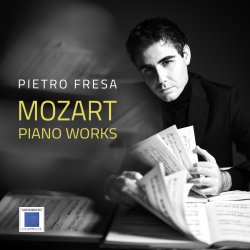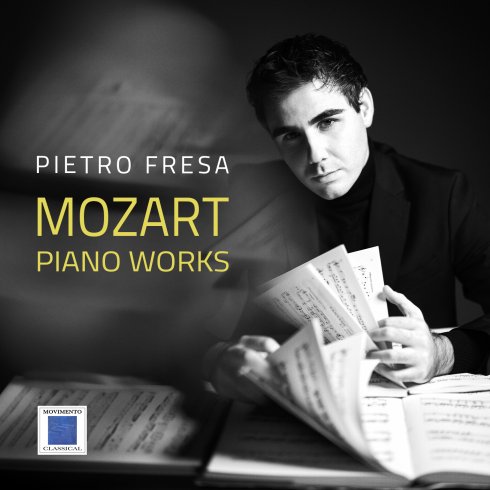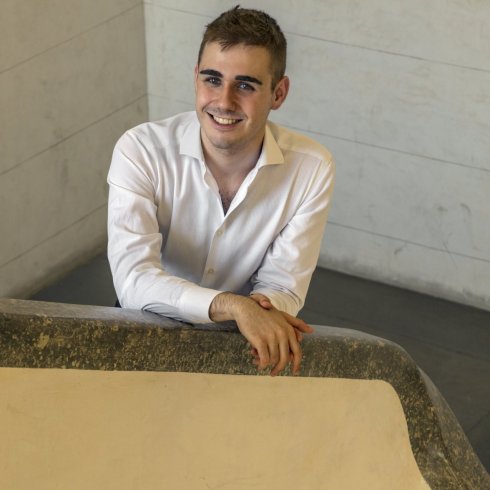

Mozart Piano works
This new recording of works by Mozart (this ltalian pianist's first recording) comes as a surprise. lt takes courage, you might say, and 22-year-old Pietro Fresa shows thai he has what it takes. He's chosen some of Mozart's
best-known works, starting with the 12 Variations on "Ahi Vous dirai-je Maman" KV 265, now perhaps out of fashion, but in the active repertory of great pianists such as Clara Haskil and Samson François. Then there's the Fantasy in d minor KV 397, Mozart's most tormented work, unfinished and diligently compieteci by an unknown hand. Then come the Rondò in O major KV 485 (which Horowitz played in his later years), the Sonata no. 5 in G major KV 283, and lastly the Sonata no. 12 In F major KV 332, the most popular along with the Sonata In a minor KV 310 (which Horowitz recorded in the studio in 1947). In March of 1987, during the recording of a Mozart cd with the La Scala Orchestra conducted by Carlo Maria Giulini, Horowitz, at the age of 83, met with the press and offered some thoughts that made the journalists jump out of their seats. 36 years later, his profound vision has developed a following. He said, "I am not interested in the speculation of others on the subject of how to play Mozart - only in what the compose, himself had to say. We are very fortunate to have so many wonderful and instructive letters, and the key to interpreting his music can be found in them. One of the most important facts that comes to light is Mozart's emphasis on feeling and expression in music-making. He continually criticized his contemporaries lor mechanical, meaningless virtuosity and a lack of feeling and sensitivity. We can see in his let ters that he was sensuous, earthy man with a wide range of emotions. He expressed them all in his music, and in thai sense he was really a Romantic compose,. To approach him as if he were a pretty, rococo porcelain figurine on a pedestal is to rob his music of its essential, universal character, its power to evoke joy as well as tears. Pablo Casals once told me that Mozart should be played like Chopin and Chopin like Mozart'"
Listening to Pietro Fresa play Mozart brings to mind what Horowitz said. His presentation of the famous French folksong "Ahi Vous dirai-je Maman" is all you need to understand that Fresa goes beyond a "corree!" reading of the text, and instead focuses immediately on the Mozartean character imparted to the folk theme: carefree, with just a bit of rococo pomposity, almost a mini-overture to the 12 Variations - especially il you consider that they were written during his unfortunate stay in Paris, !rom March to September 1778, alter his break with Hyeronimus Colloredo, the Archbishop of Salzburg, lor whom he (and his father Leopold) worked, alter failed attempts to request a higher salary and denied permission to travel and go on tour abroad. A very difficult six months in Paris, one of the worst periods of his lite: the 21-year-old Mozart had to cope with deceitful people, the aloof French society, his mother's death, and his inability to write an opera in French. Nevertheless, in addition to the Symphony in D major KV 297, he published four sets of variations lor keyboard on French themes: "Ah, vous dirai-je Maman," "Je suis Lindor, " "La belle Françoise," and "Lison Dormait." The 12 Varlatlons KV 265 on the folk song" Ah, vous dlral-je, Maman" (published in France in 1761 by Slovenian composer Nicolas Dezède (1745-1792)), most probably composed lor teaching purposes, was designed to exercise basic technical problems such as scales, arpeggios, and ornaments. Although the technical aspect is the least interesting one, when we listen we are struck by the subtle ornamentation in each variation, by their individuai beauty, by the daring harmonic treatment with its constant contrasts of major and minor seconds. "Nothing very complicateci, but with grace, tenderness, the ability to understand the psychology of the child's world thai tells us that the composer was first of alla playwright" (Piero Rattalino).
Arnold Schònberg pointed out that Mozart' instrumental works display "the ability of a great opera buffa compose, to gel by with very little." A perieci example is the so-called "Parisian" Sonata In F major KV 332 (although in 1986, musicologists Wolfgang Plath and Alan Tyson, after studying numerous manuscripts, concluded thai it was written in Munich or Vienna some time between 1781 and 1784). The Sonata is a classic example of a compact thematic structure with strong contrasts and vivici chiaroscuro. The first movement is based on two main themes set against two unexpected secondary themes, the first of which is forte with a sudden modulation to d minor (which might have inspired the aria "La donna è mobile" in Giuseppe Verdi's Rigoletto), while the second is marked by a series of sforzatiwith a movement of alternating hands that brings the young Beethoven to mind. The Adagio is in bithematic form without development - a magnificent aria sung by a great heroine, a wonderful lyric oasis belare the whirling, virtuoso third movement, marked Allegro assai.
On the other hand , the Sonata in G major KV 283 belongs to the so-called "6 Munich Sonatas" composed in just a few months between 1774 and 1775. lt opens with a very lyrical melody (Allegro) that charms the listener
imme diately , and then launches into a series of adventures with variations in 3/4 and 6/8 and various dynamic contrasts, with accents on weak beats creating a humorous effect. The second movement, Andante, is another miniaturized opera scene, a piece of ensemble music with a strong bel canto character and a great deal of ornamentation. This gives the young Pietro Fresa an opportunity to charm us with elegant flourishes and small variations (especially in the refrains), according to modem performance practice. And he does this very well, displaying his pianism to best advantage, with taste and personality. The third movement, Presto, demands great virtuosity: an explosion of joy, a roaming spirit with irrepressible inventiveness.
The same spirit permeates the delightful Rondo in D major KV 485, a piece !rom 1786 that is actually a first Sonata movement on a single theme, with a development section and a repeat thai bubbles with carefree abandon. lt was written lor a Iemale pupil (we have only her surname: van W0rben). The theme, already appearing in the Piano Quartet in g minor KV 478, is originally !rom the Quinte! op. 12 no. 6 by Johann Christian Bach (son of Johann Sebastian), Mozart's dear friend, who was there lor him when his mother died and to whom Mozart was genuinely devoted. The very amusing finale, which Horowitz loved, contains a ground bass that is a "prelude to the finale of the Piano Trio in B-flat major KV 502, in which Mozart offers usa boogie-woogie festival" (William Glock).
The very famous Fantasy in d minor KV 397, unfinished (but compieteci by composer August Eberhardt Muller with ten final bars tor the posthumous edition in 1804), belongs to the group of "Neo-Baroque" compositions in spired by the work of Cari Philipp Emanuel Bach and by Mozart's study of J.S. Bach's works in 1782 (the same year as Abduction from the Seraglio). One of Mozart's most fascinating and debated works, a precursor of the ro mantic spirit, it was enormously popular in the 19th century (and stili is among amateur pianists). Constructed in three parts, it is a striking piece of theater: opening with a serious and meditative prelude in arpeggios (Andante) of extraordinary dramatic effect, it then moves to a sweetly solemn Adagio whose two themes are interrupted by two virtuoso cadenzas that extend its expressive tension, as in fermatas left to the discretion of opera singers. And then, yet another Mozartean coup de théatre: without any pause, the music flows into a carefree, almost cheerful third part, Allegretto in O major, abruptly interrupted at bar 97.


Pietro Fresa
Pietro Fresa attended the G.B. Martini Conservatory in Bologna obtaining the highest score where he graduated under the guidance of Maestro Carlo Mazzoli, with honors and honorable mention in July 2017. He studied with the Chinese concert artist Jin Ju, and is currently a student of the famous Russian Maestro Boris Petrushansky at the prestigious International Piano Academy "Incontri col Maestro" in Imola. He began his studies at the Royal College of Music in London thanks to an important scholarship, and here, attending the courses of Maestros Dmitri Alexeev and Sofya Gulyak, he graduated with honors in September 2020. He began an intense concert activity both as a soloist and in chamber music ensembles that led him to perform in numerous festivals both in Italy and abroad, to the point of sharing the stage with artists of the caliber of cellist Mario Brunello. Among the festivals in which he has been the protagonist: the concerts of the Aula Magna of the Roma Tre University, the Palladium Theater and Palazzo Braschi in Rome, the prestigious season of Musica Insieme at the Manzoni Auditorium in Bologna, Bologna Festival, Genus Bononiae, Musica in Fiore at the Sala Farnese of the Municipality, San Giacomo Festival at the basilica of the same name, the Concerts of the Teatro Comunale, of the Teatro Guardassoni, of the Cenobio di S. Vittore, of the University of Letters, of the University of Letters, the review of the Circolo Ufficiale, the Talenti in Musica season of Modena, the Literary Society of Verona, the Festival Talent Music Mater Courses of Brescia as well as the concerts of the Teatro Sancarlino of Brescia
